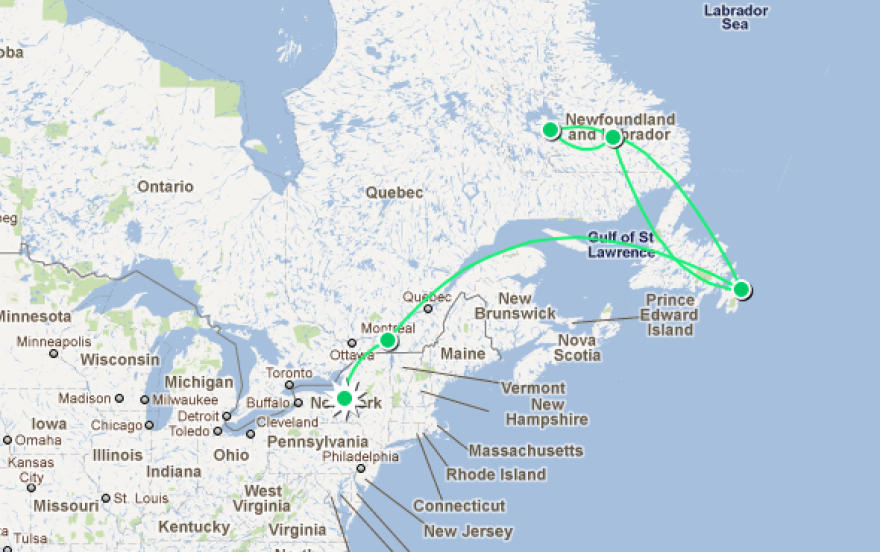You can’t really talk about power in New York State without talking about Canada.
In 2009, New York produced only 13 percent of what’s referred to as its “primary energy requirements.” The rest of it - the gas in your car, the coal and natural gas that our power plants burn, the uranium for our nuclear reactors, the power we import directly into our grid - came from somewhere else.
That last part is where Canada fits in. Most of our imported electricity comes from Canadian hydroelectric dams.
All in all, Canadian hydro accounts for just under six percent of power in New York’s grid [PDF]. In 2010, New York imported almost 3 million megawatt hours [PDF] from Canada, at a cost of about a half a billion dollars.
But that Canadian hydro isn’t without controversy.
Here in the U.S., former governor Mario Cuomo canceled a huge contract with Hydro Quebec in the 1990s following pressure from Native American and environmental activists. And now there’s a new wave of plants set to come online, with $50 billion worth of construction slated for the provinces of Quebec, and Newfoundland & Labrador, alone.
The other end of the line
So we decided that we had to take a look at what’s at the other end of one of our transmission lines. That means I’ll be embarking on a trip to Canada to look at the history of American dependence on Canadian energy, and to explore what’s on the horizon. Here are the stories I’m working on:
Crossing the border - In the tiny border town of Fort Covington, the power lines that crisscross the border quietly hum along, just like any other transmission line. But they’re the result of turbulent times in the 1970s, when a group of activists faced arrest to camp out under a 95-year-old elm tree, to protest the installation of the lines above their town. The future Canadian hydro transmission to the U.S. may be less visible - it’s slated to travel out of sight under the Hudson River, from Quebec all the way to New York City - but it’s no less controversial among advocates for renewable energy.
Joining the fray - Partly by geography, and partly as a matter of policy, Quebec has dominated the hydropower playing field for decades. The province has huge dams (mostly in the far north) which supply 95 percent of the province’s power on the cheap - before the rest goes out on the market to Canada and the U.S. To serve up more juice, the provincial power authority, Hydro Quebec, has steadily been building dams further and further north. But new provinces - including Manitoba, in central Canada, which is adding dams, and Newfoundland & Labrador (one province, two names) - want to get a bigger piece of the lucrative game, and have launched ambitious proposals to compete with Quebec.
The end of the line - Sometimes it’s hard for Americans to grasp the finer points of Canadian geography (I have dual U.S.-Canadian citizenship, so I have an advantage). So some quick background on Labrador might be useful. It's just below the Arctic Circle on the Atlantic Coast, and has about a quarter the population density of Alaska - the U.S.’s most sparsely populated state.
Labrador is planning its second major hydroelectric facility, and has signed a business plan and community benefits agreement with the Canadian First Nation that will lose access to traditional hunting grounds when the dam is flooded, but some detractors have voiced concerns about the mega-project’s environmental impacts.
Have your say
The road trip will have side trips of course, because that’s what road trips are all about. I’ll explore the island of Newfoundland, where its economic mainstay - cod fishing - has been devastated by overfishing. The province is in the process of reinventing its economy with offshore oil and tourism (that should sound familiar to most of our readers in the Empire State).
I’m also excited to check out the phenomenon of former fishermen harvesting floating icebergs. They’re turned into what’s being marketed as “bergie bits” (that’s ice cubes made from icebergs), and into beer.
One story I won’t be getting to is the current debate over extracting oil from the Canadian tar sands. But you can read up on that controversy at the New York Times.
I’ll be traveling over the next two weeks, so if you have questions or suggestions for the road - trail mix, if you will - we’d love to hear them. When I can, I’ll tweet you some updates and photos over at @ecjacobs.






